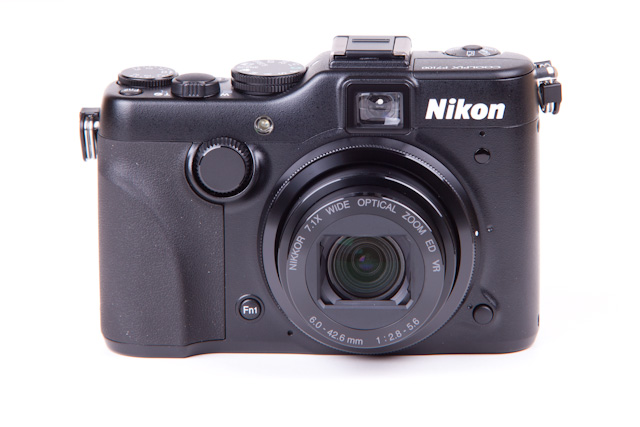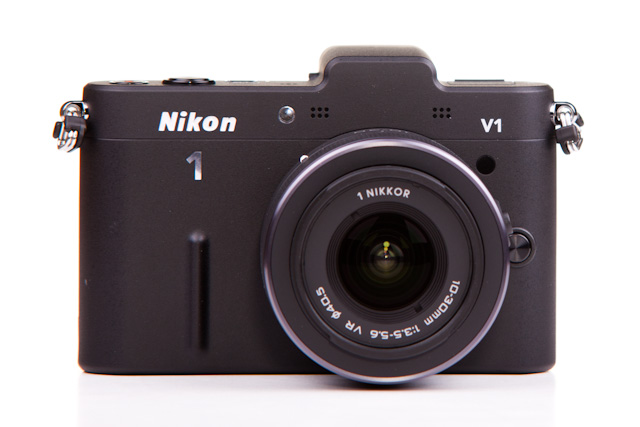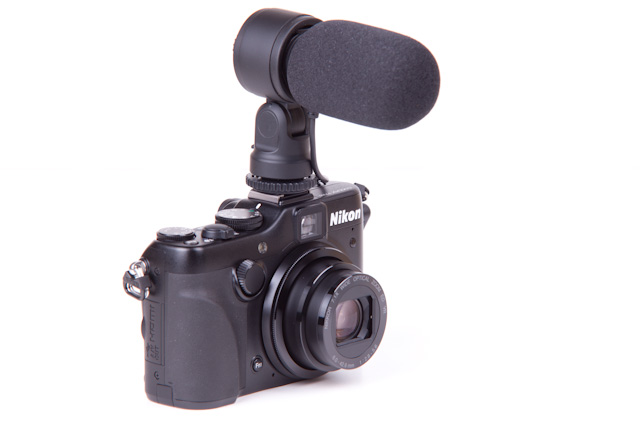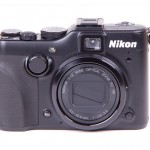The Nikon P7100 is the latest prosumer compact in the Coolpix lineup. When I reviewed the Nikon P7000 earlier this year, my biggest complaint was the speed of the camera in terms of shot-to-shot raw image capture and navigation of the menu system. Nikon has clearly addressed those concerns in the P7100 model, allowing the camera to compete on level ground with Canon’s G12 and other prosumer compact cameras.
Nikon P7000 Key Features
- 10.1MP 1/1.7-inch CCD image sensor
- 720p HD video
- 7.1x optical zoom (28-200mm equivalent)
- Optical Vibration Reduction
- ISO 100-6400 at full resolution (ISO 12800 at 3MP)
- Articulating 3-inch 921k-dot resolution LCD
- Optical viewfinder
- RAW file capture
- Hot shoe
- External mic port
Nikon P7100 Handling, Operation and Controls

If some of this review sounds familiar, that’s because portions were taken directly from the P7000 review from earlier this year. The key differences in the cameras being the improved performance/speed and the addition of a couple of new specs, like the articulating LCD.
Like the Canon G12, the Nikon P7100 is a more substantial of a camera to handle than your typical point and shoot. However, if you are looking for a typical point and shoot, then the P7100 really doesn’t enter into the equation for you anyway.
This is not a pocket camera – unless you are throwing it into a heavy coat pocket or large cargo shorts pockets. That said, it’s still much smaller and convenient for all-day carry than a DSLR. Additionally, the built-in lens, which retracts fully into the body, gives the P7100 a size advantage over the ever-shrinking “mirrorless” cameras out there (e.g., Olympus E-P3, Sony NEX-5N, etc.).

Unlike a lot of point and shoot cameras, the P7100 sports a proper rubberized grip along the right edge to give your “shooting hand” something to hold onto while working your magic. One of the new bells or whistles on the P7100 as compared to the P7000, is the inclusion of the front control dial that’s within reach of your right index finger when gripping the camera.
Put your hands on the camera and you have a plethora of controls at your fingertips without the need to go menu diving. On top of the camera, you get easy access to PASM shooting modes via a DSLR-like mode dial, which also offers user-customized modes and video capture mode. Another handy dial is the dedicated exposure compensation dial, which lets you adjust +/- 3EV in one-third increments (a very handy and efficient dial).
Nikon incorporates a number of customizable settings into button/dial combo to the left of the camera’s hot shoe. While this control took a bit to warm up to, I like the concept. Need to adjust ISO? Rotate dial to ISO, push center button and then choose your poison. White balance, image quality and bracketing options, among others, can also be found in this hybrid dial.
Next to the large viewfinder on the back of the camera, you will find your typical array of menu, preview and info buttons, along with a 4-way controller button with an integrated scroll wheel.
The large scroll wheel is easily accessible via the right thumb and is the counterpart to a scroll wheel about an inch above it near the thumb pad. When I reviewed the P7000, I complained about the awkwardness of using these two scroll wheels for controlling some settings. I noted that it would be nice to have a scroll wheel within reach of the right forefinger when gripping the camera. And, as noted above, that’s exactly what Nikon has done with the P7100, which makes it a more intuitive operation when you have dueling parameters to control at the same time. A big kudos to Nikon on that one.
Image Quality

As you would expect from a camera with a feature set like the P7100, images turn out quite well. Even at higher ISOs, the P7100 delivers plenty of usable shots. In fact, if you shoot in RAW format, you can get quite a bit of mileage out of the P7100?s high ISO files. It’s pretty clear that things start to break down around ISO 1600 and you’ll want to stick to smaller prints or web images as you push above ISO 800.
What the camera won’t do, however, is stand up against larger sensor cameras like the Nikon D7000 and even the new 1 Series models. It’s still a compact sensor and, treated as such, the P7100 should serve you quite well.
For a camera this size, I don’t really have any complaints about the images that come out of it. If image quality were the sole measure, I’d be as happy to pack the P7100 as any other point and shoot model. The ability to work in Nikon’s i-TTL system and make easy adjustments to exposure compensation adds to the creative control for your images.
Below you’ll find a few images that I captured with P7100, which were converted from RAW files to JPG using Lightroom 3.
Feel free to download any of these sample images for your personal inspection (not for republication). You can get the original files by right-clicking on any of the images and choosing “Save link as…”

Above Image at 100% Crop

Nikon P7100 compared to Nikon V1 and Nikon D7000 at ISO 800

Nikon P7100 compared to Nikon V1 and Nikon D7000 at ISO 1600
Compared to the Nikon 1 Series

At first blush, it would seem that the Nikon P7100 is an odd fit in Nikon’s lineup now that the new mirrorless Nikon 1 Series is out. I think a closer examination of the cameras and features suggests otherwise and that the Nikon P7100 still has a firm place in the market.
Based on my use and Nikon’s own marketing comments about the 1 Series, I think the P7100 is a camera for a much more “serious” shooter, while the 1 Series is geared more toward the casual photography crowd who may not necessarily understand all of the ins and outs of camera operation.
The P7100 seems to me more like a DSLR enthusiast or pro shooter’s pocket camera. The ability use Nikon’s iTTL system with the P7100, and the plethora of manual controls fit the serious shooter better than the rather point-and-shoot control scheme of the Nikon 1 Series.
The downside of the P7100 when compared to the Nikon 1 Series is image quality. The smaller sensor in the P7100 just doesn’t hold up to the larger sensor in the Nikon V1. However, the P7100 is in line with other serious point-and-shoot cameras on the image quality front.
Accessories

Nikon EN-EL14 Battery – The Nikon P7100 comes with one of these rechargeable lithium-ion batteries; however, if you’re going to be away from power for an extended period, you can pick up spares.
Lexar Platinum SDHC Card – Nikon recommends using a Class 6 or higher SD card with the P7100. While the P7100 will definitely benefit from using a faster card, don’t feel like you need to purchase the fastest of the fast cards. The Lexar Platinum series is a good mix of speed and price for the Nikon P7100. Again, any SDHC or SDXC card with a Class 6 or higher rating will allow you to record uninterrupted video. You can read more about the types and speed classes of memory cards available in my reference article, Demystifying SD Cards.
Nikon SB-400 Speedlight – A basic bounce flash, which is really all you need with the P7100.
Nikon SB-700 Speedlight – If you want more power and features in you flash, then you could step up to this flash. Note, however, that it will also add some bulk to your setup.
Memory card reader – If you don’t own a memory card reader, they make transferring images to your computer a world faster. I highly recommend picking one up with the P7100. They’re cheap and big time saver.
Nikon ME-1 Stereo Mic – The Nikon ME-1 is a decent little external mic for the P7100 and other cameras that offer a mini mic port. It does a good job of capturing stereo sound, and if you are going to use the P7100 as a video camera too, then it’s a fairly affordable add-on.
Conclusion

The Nikon P7100 is the camera that its predecessor should have been. If you have been holding out on the P7000 because of its questionable performance, wait no longer. Nikon has delivered a worthy raw-shooting competitor to the Canon G12.
If you’ve got Nikon speedlights in your camera bag, this should be a no-brainer. If you’re on the fence between the Canon and Nikon cameras, I don’t have a tie-breaking vote for you. They are both solid cameras and are near equals in terms of real world use expectations.
As a result, the Nikon P7100 gets a high recommendation from me as a prosumer compact camera for intermediate to advanced users.
The Nikon Coolpix P7000 is available from Photography Bay’s trusted retail affiliates at the following links:
By making your photography purchases at B&H Photo through these links, you are helping Photography Bay to continue bring quality camera tests, news and reviews. Thanks for your continued support.





























Thank you, this helped greatly.